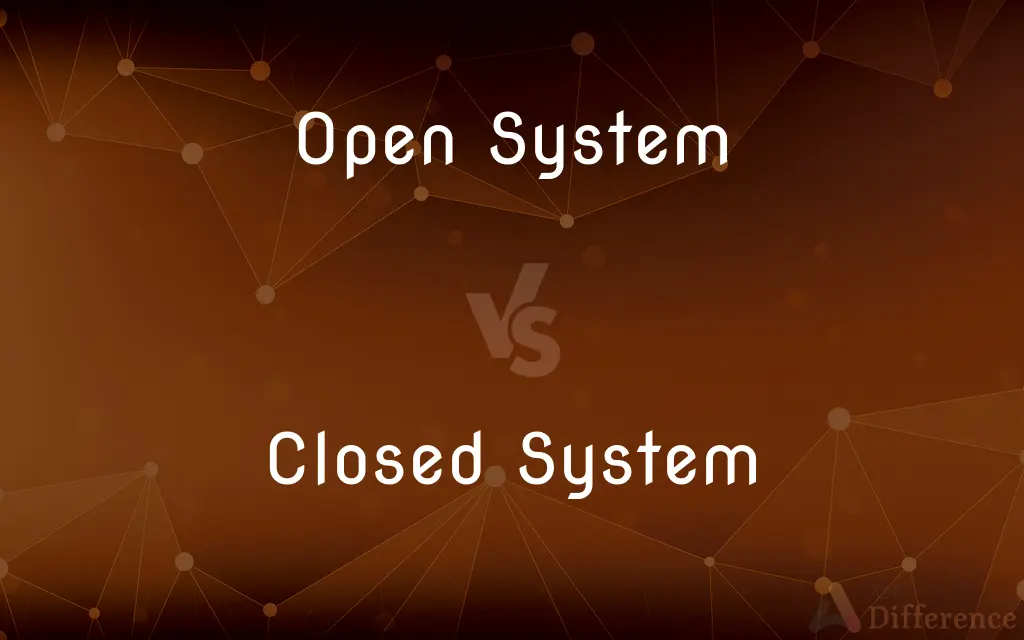Open System vs. Closed System — What's the Difference?
By Tayyaba Rehman — Published on October 23, 2023
Open System exchanges matter and energy with surroundings, while a Closed System allows energy but not matter exchange.

Difference Between Open System and Closed System
Table of Contents
ADVERTISEMENT
Key Differences
An Open System notably engages in the transfer of both energy and matter with its external environment, facilitating a dynamic interaction that perpetually impacts and is impacted by external forces. Conversely, a Closed System distinctly restricts the exchange of matter with its external surroundings, albeit, it may permit the exchange of energy, ensuring an intrinsic difference in interactional dynamics between the two.
In the realm of an Open System, the incessant interaction with its environment can herald adaptations, evolutions, and a perpetual state of fluctuation, attributing to a malleable and adaptive operational modality. On the contrary, a Closed System adheres to a more isolated operational modality, wherein the system is substantially more insulated from the influencing machinations of external variables, thereby manifesting a relatively stable internal environment.
Analyzing an Open System reveals a permeable boundary that allows for the seamless transition of both matter and energy across its confines, promoting an innate susceptibility to environmental influences and an integrated relationship with its surroundings. In stark contrast, the boundaries of a Closed System are decidedly impermeable to matter, culminating in a selective interaction with its surroundings, predominantly through the controlled exchange of energy.
From a thermodynamic perspective, an Open System is inherently predisposed to changes in entropy owing to the unregulated exchange of matter and energy, thereby subscribing to a continuous state of dynamic instability. In opposition, a Closed System can maintain a relatively stable state of entropy, particularly if it’s isolated from external energy exchanges, which can be attributed to its restrictive boundaries and resultant diminished interaction with external parameters.
Comparison Chart
Matter Exchange
Permits matter and energy exchange
Does not permit matter exchange
ADVERTISEMENT
Energy Exchange
Permits energy exchange
Permits energy exchange
Interaction with Surroundings
High interaction
Limited interaction
Stability
Less stable due to constant exchange
More stable with restricted exchange
Adaptability
Highly adaptable to surrounding changes
Less adaptable to changes
Compare with Definitions
Open System
Exhibits permeable boundaries for matter and energy.
A boiling pot is an open system as it allows steam to escape.
Closed System
Exhibits a selective boundary, allowing limited external interaction.
A thermos keeps coffee hot, acting as a closed system by limiting energy exchange.
Open System
Involves direct exchange with its external environment.
A pond, receiving rainwater and sunlight, is an open system.
Closed System
Primarily insulates its internal processes from external influences.
A closed economy, ignoring international trade, functions as a closed system.
Open System
Possesses dynamic stability due to external interactions.
The ocean is an open system, exchanging heat and matter with the atmosphere.
Closed System
Maintains a more stable internal environment.
An isolated lab environment can be considered a closed system during experiments.
Open System
Continually interacts and adapts to its environment.
A business operating as an open system adapts to market trends and changes.
Closed System
Involves minimized interaction with external parameters.
A sealed terrarium operates largely as a closed system, having minimal matter exchange.
Open System
Permits interaction of matter and energy with surroundings.
An ecosystem is an open system as it exchanges energy and matter with its surroundings.
Closed System
Restricts matter exchange but may allow energy interaction.
A sealed bottle of water represents a closed system as it prevents matter exchange.
Common Curiosities
What distinguishes an Open System from a Closed System?
Open System allows exchange of matter and energy with surroundings, while Closed System restricts matter exchange.
What is an example of an Open System?
An example of an Open System is an ecosystem, due to matter and energy exchange.
How does a Closed System maintain stability?
A Closed System maintains stability by restricting matter exchange, limiting environmental impact.
How does an Open System adapt to changes?
An Open System adapts by interacting and exchanging matter and energy with its surroundings.
Can a Closed System exchange energy?
Yes, a Closed System can exchange energy but not matter with its environment.
Is the human body an Open System?
Yes, the human body is an Open System as it exchanges matter and energy with its environment.
Can a system be both open and closed in different contexts?
Yes, depending on the aspect being considered (e.g., energy or matter), a system may be open or closed.
What is a key feature of the boundaries of a Closed System?
The boundaries of a Closed System are selective, primarily restricting the exchange of matter.
Why is a thermos considered a Closed System?
A thermos is considered a Closed System as it largely restricts the exchange of matter and energy.
Is a car engine an Open System?
Yes, a car engine is an Open System because it exchanges heat and matter (exhaust) with its surroundings.
Share Your Discovery

Previous Comparison
Rank vs. Title
Next Comparison
Enclosed vs. SurroundedAuthor Spotlight
Written by
Tayyaba RehmanTayyaba Rehman is a distinguished writer, currently serving as a primary contributor to askdifference.com. As a researcher in semantics and etymology, Tayyaba's passion for the complexity of languages and their distinctions has found a perfect home on the platform. Tayyaba delves into the intricacies of language, distinguishing between commonly confused words and phrases, thereby providing clarity for readers worldwide.
















































